Where you see this button
Spider Collector's Journal (23rd page: 2013) Copyright © 2013 by Rod Crawford
Here's the 23rd page of narratives of fun (and not so fun)
trips to collect spiders for research at the Burke
Museum, with a variety of transportation (no one field driver available more than 3 times). Most also appeared in Scarabogram, newsletter of "Scarabs:
The Bug Society." Dates of field trips head each paragraph. Maps showing
the location of sites within Washington state follow the grid system outlined
in the Washington
Spider Checklist. RETURN
TO INDEX
Where you see this button ![]() in a
field trip account, click it to get a page of collecting site photos!
in a
field trip account, click it to get a page of collecting site photos!
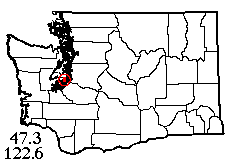 |
![]() 10 II 2013: The annual spell of good weather in February coincided with volunteer Lauren Taylor’s availability on Sunday, and I picked a site based more on potential for dry habitats than on real collecting need, the Gig Harbor Peninsula about 10 miles from the west end of the Tacoma Narrows Bridge, where I had a couple of species recorded from home specimen submissions. The early fog melted as we drove and it became bright and sunny in Tacoma. Alas, our destination remained cloudy all day, but at least most of the vegetation was dry! Our first stop was McCormick Forest Park, a county site popular with dog-walkers. This 122-acre natural area has well-maintained trails and scattered old-growth hemlock trees left behind by the loggers. We hiked to an area with picnic tables, where I sifted several loads of alder litter (5 spider species) and some moss (9 species). Lauren beat the small amount of fir and hemlock foliage that was accessible, and we both beat salal-fern understory (which had a nice population of pretty little Theridion californicum, among others). For our last couple of hours in the park, we hiked around (skirting the adjacent Corrections Center for Women) in search of other habitats. On the west side of a deep ravine I got access to some big maple trees, but the litter wasn’t as productive as expected, though it added 3 species. We finally located some decent conifer foliage to beat (not all native species) in the grounds of a fire station across the road from the parking area.
10 II 2013: The annual spell of good weather in February coincided with volunteer Lauren Taylor’s availability on Sunday, and I picked a site based more on potential for dry habitats than on real collecting need, the Gig Harbor Peninsula about 10 miles from the west end of the Tacoma Narrows Bridge, where I had a couple of species recorded from home specimen submissions. The early fog melted as we drove and it became bright and sunny in Tacoma. Alas, our destination remained cloudy all day, but at least most of the vegetation was dry! Our first stop was McCormick Forest Park, a county site popular with dog-walkers. This 122-acre natural area has well-maintained trails and scattered old-growth hemlock trees left behind by the loggers. We hiked to an area with picnic tables, where I sifted several loads of alder litter (5 spider species) and some moss (9 species). Lauren beat the small amount of fir and hemlock foliage that was accessible, and we both beat salal-fern understory (which had a nice population of pretty little Theridion californicum, among others). For our last couple of hours in the park, we hiked around (skirting the adjacent Corrections Center for Women) in search of other habitats. On the west side of a deep ravine I got access to some big maple trees, but the litter wasn’t as productive as expected, though it added 3 species. We finally located some decent conifer foliage to beat (not all native species) in the grounds of a fire station across the road from the parking area.
Not far to the northwest, Purdy Sand Spit is also public-accessible county property. Unfortunately there is a very busy highway along the entire length of the spit. The natural sandspit habitats are degraded almost to vanishing point, but we did manage to sweep 4 additional species from tiny sad remnants of meadow and marsh, and I got Erigone aletris under driftwood (after turning over about a hundred chunks, oh my stiff knees). Soon after we left (having exhausted the possibilities of the spit), dusk closed in leaving us with 31 species for the day.
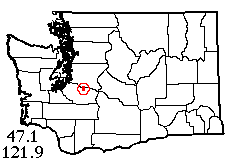 |
![]() 17 IV 2013: Volunteer drivers who hadn’t looked at their appointment calendars until the eleventh hour had scuttled my trip plans during Easter week, so this time, when another weather window opened I was prepared with a bus-trip plan. Sure enough, it happened again and I found myself on a three-bus parlay from Seattle to Enumclaw. Deposited in central Enumclaw, I had to walk about 2 miles down roads mostly without sidewalks, then I was at an undeveloped part of the (presently inactive) King County fairgrounds. The tract is clearly popular with dog-walkers. One woman had a pack of about 5, ranging from a black Labrador to a Chihuahua, all of which circled me barking until she called them off, explaining they were afraid of my net!
17 IV 2013: Volunteer drivers who hadn’t looked at their appointment calendars until the eleventh hour had scuttled my trip plans during Easter week, so this time, when another weather window opened I was prepared with a bus-trip plan. Sure enough, it happened again and I found myself on a three-bus parlay from Seattle to Enumclaw. Deposited in central Enumclaw, I had to walk about 2 miles down roads mostly without sidewalks, then I was at an undeveloped part of the (presently inactive) King County fairgrounds. The tract is clearly popular with dog-walkers. One woman had a pack of about 5, ranging from a black Labrador to a Chihuahua, all of which circled me barking until she called them off, explaining they were afraid of my net!
Dogs were the least of my problems. I had hoped to cross the grassy areas to an extensive, county-owned forest tract, but the farther half of the grass was actually a golf course – public, but thoroughly fenced off. Moreover, when I started collecting in the huge field on the fairgrounds side, I had great difficulty finding any spiders! With the sun shining, Pardosa should have been everywhere; I managed to collect 1 specimen. Most of my grass sweeps came up empty, even in a natural-looking wetland tract. I had to conclude that the golf course used a lot of pesticide, and it had drifted! A little farther north, the golf course fence disappeared into a wooded hill, and with that between me and the chemical lawn, I finally started getting specimens. With much labor, I finally put together a quite decent ten-species sweep sample. A thorn-beset path through the blackberry barrier brought me to the little wooded hill, where there was actually a gap through the fence.
Leaf litter was sparse, but consisted largely of maple leaves, which rarely fail to provide spiders. I sifted 12 spider and 3 harvestman species, more than I realized at the time, plus one lonely Cybaeota from the scanty moss on a tree. Through the fence, fern understory had 10 spider species of its own, while the dog at a nearby house voiced its displeasure at my presence (I guess I might subtitle this trip ‘The Howling.’) Having exhausted the habitats at this site, I drifted back toward the road, scanning fences and fair buildings for house spiders and finding none. But right at the road were some planted fir, cedar and spruce trees whose foliage added 2 more species. Despite being disappointed by most of the habitats, I had actually bagged 30 species for the day, not to mention a day in the country and plenty of exercise, so I can’t complain.
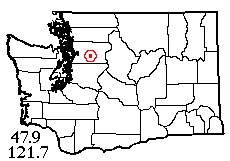 |
![]() 24 IV 2013: Yet once more, a volunteer driver discovered a more pressing engagement the day before the field trip. Fortunately I had another bus plan in place for this gloriously sunny spring Wednesday. It's quite easy to take a bus from my place to the town of Sultan in south central Snohomish County, but I'd already collected at both ends of the town itself. However, I figured I could walk the 3 miles necessary to reach the next grid-area to the north. And I did! Traffic was light on Sultan Basin Road; dog territoriality was much in evidence, but a little barking can't hurt – as long as it eventually stops. I found my goal, a long-unused road into timberland, easily; and just 140 meters into the woods, peace descended. The habitat was nothing special, a stand of alders and maples within skinny third-growth hemlocks, but boy was it peaceful there! Despite the proximity of rural residences, sounds from the outside world were few and far between. The site lacked invasive plants (except for one enclave of ivy on a stump) and even invasive spiders. I saw only one mosquito, probably a Culiseta just out of hibernation.
24 IV 2013: Yet once more, a volunteer driver discovered a more pressing engagement the day before the field trip. Fortunately I had another bus plan in place for this gloriously sunny spring Wednesday. It's quite easy to take a bus from my place to the town of Sultan in south central Snohomish County, but I'd already collected at both ends of the town itself. However, I figured I could walk the 3 miles necessary to reach the next grid-area to the north. And I did! Traffic was light on Sultan Basin Road; dog territoriality was much in evidence, but a little barking can't hurt – as long as it eventually stops. I found my goal, a long-unused road into timberland, easily; and just 140 meters into the woods, peace descended. The habitat was nothing special, a stand of alders and maples within skinny third-growth hemlocks, but boy was it peaceful there! Despite the proximity of rural residences, sounds from the outside world were few and far between. The site lacked invasive plants (except for one enclave of ivy on a stump) and even invasive spiders. I saw only one mosquito, probably a Culiseta just out of hibernation.
I started with litter sifting, ending with 10 spider species plus some nice myriapods. Nesticus silvestrii was unusually abundant in the maple litter, but absent in alder litter. There was moss on the trees (one reason I'd stopped there) and this added 6 more. The forest understory was well-developed, mostly of ferns and Dicentra, but only added another 4 species. Hardly any conifer foliage was reachable, but one low roadside hemlock branch gave me Pityohyphantes rubrofasciatus. At first it appeared that the only source of dead wood was a few giant stumps, surprisingly widely scattered in the seral forest; perhaps they were only the cedar stumps, fir stumps having perished in the century-plus since the site was first logged. In any case, the few fragments I could break off produced no spiders. Finally I discovered that I could tap some spiders (all common, as it turned out) from some 3-inch-diameter "logs" lying inconspicuously on the forest floor. It was now time to start the long walk back to Sultan; on the way out, I added 3 grass species from the roadside, unfortunately too shaded to make wolf spider habitat. My total catch was only 25 species, adequate if not great, but it was a very pleasant place to spend the day; and that same old road I walked goes on into more new territory!
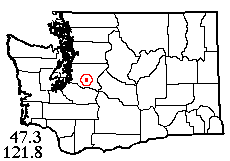 |
![]() 1 V 2013: The week’s good weather fell on Wednesday again; and Lauren was actually available to drive on a field trip! The catch: she had to be back in town by 5 pm. So I used a trip plan I’d made for shorter days of early spring, and we headed for the recently established Kanaskat Natural Area, on the Green River in extreme south central King County, sandwiched between the restricted Cedar River and Green River watersheds. My downloaded driving directions worked perfectly, and we were on site, parked just before a gate at the area boundary, in about an hour on this perfect cloudless day. We were fortunate to meet a county official just leaving, who assured us that the “no trespassing” signs applied to private inholdings and not to the county land! Also on site were 2 truckloads of Washington Conservation Corps crew, planting willow saplings in the (presumably cleared) grassland plots.
1 V 2013: The week’s good weather fell on Wednesday again; and Lauren was actually available to drive on a field trip! The catch: she had to be back in town by 5 pm. So I used a trip plan I’d made for shorter days of early spring, and we headed for the recently established Kanaskat Natural Area, on the Green River in extreme south central King County, sandwiched between the restricted Cedar River and Green River watersheds. My downloaded driving directions worked perfectly, and we were on site, parked just before a gate at the area boundary, in about an hour on this perfect cloudless day. We were fortunate to meet a county official just leaving, who assured us that the “no trespassing” signs applied to private inholdings and not to the county land! Also on site were 2 truckloads of Washington Conservation Corps crew, planting willow saplings in the (presumably cleared) grassland plots.
As long as there was temporarily still some grassland, I started my collecting there. Pardosa vancouveri were active in some numbers, but sweeping (in grass mostly either too short or too wet) produced only 3 additional species. Lauren and I both worked for a while at beating conifer foliage (some of it Sitka spruce – ouch), adding 8 species including a gorgeous female Pityohyphantes rubrofasciatus. Next, I found some good maple litter to sift near the river, adding 6 more species (I'd thought it was 10) including several nice plump little Neon reticulatus. Moss on the same maple trees added only 2 more. Lauren had been sweeping understory but hadn’t got much besides Metellina curtisi, so I showed her how it was done and added Neriene litigiosa, Hyptiotes gertschi and others. I found a nice big Cybaeus under riverside rocks. We’d met the man (Jack Frost, I kid you not) who lives on a private inholding, and he’d told us of a nice old-growth stand "a sixteenth of a mile" past his house. We had an hour before we had to leave, so we headed there, but soon realized we couldn’t reach it in time. I plotted it on Google Earth and it’s really 0.34 miles. Back at the car, I took Neriene digna from webs on a rock face, and we swept roadside verge with little result; but we did get 26 species for the day, making it back with time to spare.
 |
![]() 5 V 2013: A recent paper in Northwest Science described a novel way to collect the rare insect order Notoptera (grylloblattids): pitfall trapping at the edge of mountain clearcuts. Both I and old friend Larry McTigue have an interest in this group, and he wanted to give it a try this year. I was happy to do so as long as I could combine it with spider collecting. Good weather finally coincided with Larry’s schedule on May 5, and we were off to the Stillaguamish Valley, where I’d identified at least one suitable clearcut we could reach without a snowplow. Alas for the vanity of human planning! Along the Green Mountain Road, just one clearcut (the one I’d identified on aerial photos) looked really suitable for the published technique. Guess what, it was the only one posted "no trespassing." On both this road and two others we tried, we encountered snow at around 2400’ elevation without reaching any more recent clearcuts. The darn things are all over the place when you don’t want to see them, but——
5 V 2013: A recent paper in Northwest Science described a novel way to collect the rare insect order Notoptera (grylloblattids): pitfall trapping at the edge of mountain clearcuts. Both I and old friend Larry McTigue have an interest in this group, and he wanted to give it a try this year. I was happy to do so as long as I could combine it with spider collecting. Good weather finally coincided with Larry’s schedule on May 5, and we were off to the Stillaguamish Valley, where I’d identified at least one suitable clearcut we could reach without a snowplow. Alas for the vanity of human planning! Along the Green Mountain Road, just one clearcut (the one I’d identified on aerial photos) looked really suitable for the published technique. Guess what, it was the only one posted "no trespassing." On both this road and two others we tried, we encountered snow at around 2400’ elevation without reaching any more recent clearcuts. The darn things are all over the place when you don’t want to see them, but——
Grylloblattids also occur in caves, and although there were no natural caves we could reach nearby, Larry knew of an accessible mine tunnel next to Red Bridge Campground. We found it easily, but the floor was solid rock right to the very end – no place to put a pitfall trap! So, there was nothing left to do but collect spiders. On one of our logging road excursions, I stopped for an hour’s tree beating at a bridge over Mallardy Creek at 1600’ elevation, an attractive site. The roadside and streamside hemlocks produced 8 species, but even better was what I got from the bridge itself: it included several of the uncommon orbweaver Zygiella dispar with webs on the railings. Collecting these was a challenge – when disturbed they dropped on a dragline many feet down toward the canyon below, and I had to hold my net just right!
I got 2 species of "cave twilight" spiders while exploring the mine tunnel by the campground. The camp outhouses added 2 more. I was too late in the spring for the large river-gravel-bar wolf spiders, but a nearby spruce tree added 2 more conifer foliage species I hadn’t got at the higher bridge site. Finally, I spent 3 hours collecting at a nice wetland that Mallardy Road crosses between the campground and bridge sites, while Larry worked on his truck. This is quite a nice site where a slow braided stream (draining away from Mallardy Creek) meanders among meadows, marsh and willow thickets; very well populated with native frogs, and I saw one nice fat toad (see album). Sweeping the not-too-tall grass gave me only 3 species, plus a solitary Pardosa vancouveri running across the meadow. But sifting willow litter was like hitting pay dirt. Seven of the 8 species I sifted are wetland specialists, including rare Eperigone lindrothi, Cybaeopsis wabritaska, and Hybauchenidium cymbadentatum! I got 3 additional species from moss, and a big spruce tree added one more conifer-dweller, for a grand total of 30. Very worthwhile, even though we didn’t manage to set any pitfall traps.
 |
![]() 11 V 2013: It was another BioBlitz at Washington Park Arboretum, organized by educator Patrick Mulligan. Scarab Angela Winner, her son Aidan and 2 other volunteers showed up to help with spiders in the "morning shift" from 10 AM to 12:30; a park recorder accompanied us. Patrick had set up a "sampling block" in the middle that unfortunately didn't contain many outstanding spider habitats. We started out sweeping understory (the first habitat we found that wasn't "groomed"), but found little except non-native species. Angela got the best specimen here, a female Misumena vatia. Forging onward, we located some maple litter (aha, always a good habitat) but this batch – which had probably been raked to its present location – had very few spiders. Some good myriapods, though! Continuing down to a reputedly "moister" area, we did come upon an unmowed grassy field, definitely a step in the right direction, and sweeping added a few species. But leaf litter had almost nothing even at this site. (See album for some cool insects Angela collected in the meantime). Then it was time to go back to the greenhouse for lunch.
11 V 2013: It was another BioBlitz at Washington Park Arboretum, organized by educator Patrick Mulligan. Scarab Angela Winner, her son Aidan and 2 other volunteers showed up to help with spiders in the "morning shift" from 10 AM to 12:30; a park recorder accompanied us. Patrick had set up a "sampling block" in the middle that unfortunately didn't contain many outstanding spider habitats. We started out sweeping understory (the first habitat we found that wasn't "groomed"), but found little except non-native species. Angela got the best specimen here, a female Misumena vatia. Forging onward, we located some maple litter (aha, always a good habitat) but this batch – which had probably been raked to its present location – had very few spiders. Some good myriapods, though! Continuing down to a reputedly "moister" area, we did come upon an unmowed grassy field, definitely a step in the right direction, and sweeping added a few species. But leaf litter had almost nothing even at this site. (See album for some cool insects Angela collected in the meantime). Then it was time to go back to the greenhouse for lunch.
None of the volunteer helpers for the 1:30-3:30 shift showed up, so I set off alone to the "Pinetum," or conifer collection. The conifer foliage rescued me from having a blah day: quite a few species were present, especially on the younger trees. Adjacent was another tall grass stand with some sedge as well, and this was considerably better (for spiders) than the previous "meadow." At the end of the event I walked south to a brushy area I'd spotted on Google Street View, but it wasn't so hot. End result, 22 spider species; 4 (2 of them native) were new to the park. I got four millipede and two centipede species also.
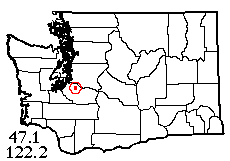 |
![]() 2 VI 2013: Since April flowers bring May showers around here, the last half of May had been field-free. But the weekend of June 1-2 promised fair, and I’d recruited a new field volunteer. Guess what, she had the flu! The weather forecast was dithering a bit so I settled on Sunday for the bus trip (dictated by which bus runs on Sunday), a straight run to Sumner station in Pierce County. There, I’d arranged to meet Lynette Schimming who lives nearby (until next month, when she’s moving, sob!) We headed due south to a trailhead for the Puyallup Riverwalk Trail, along the south bank of that river. In a half mile we came to some public land where the blackberries were interrupted by a giant grassy field with small ponds inland, and a nice cottonwood belt with dense shrub understory bordering the sand/gravel bar on the river. After all those sites with few wolf spiders, I was glad to find the field swarming with Pardosa vancouveri. I swept grass for some time, while Lynette followed along photographing all the photogenic spiders I found. The grass produced 11 species including Metaphidippus mannii. Lynette got a few others from under rocks and logs (including Enoplognatha thoracica), from a baby cottonwood tree, and even blackberry vines.
2 VI 2013: Since April flowers bring May showers around here, the last half of May had been field-free. But the weekend of June 1-2 promised fair, and I’d recruited a new field volunteer. Guess what, she had the flu! The weather forecast was dithering a bit so I settled on Sunday for the bus trip (dictated by which bus runs on Sunday), a straight run to Sumner station in Pierce County. There, I’d arranged to meet Lynette Schimming who lives nearby (until next month, when she’s moving, sob!) We headed due south to a trailhead for the Puyallup Riverwalk Trail, along the south bank of that river. In a half mile we came to some public land where the blackberries were interrupted by a giant grassy field with small ponds inland, and a nice cottonwood belt with dense shrub understory bordering the sand/gravel bar on the river. After all those sites with few wolf spiders, I was glad to find the field swarming with Pardosa vancouveri. I swept grass for some time, while Lynette followed along photographing all the photogenic spiders I found. The grass produced 11 species including Metaphidippus mannii. Lynette got a few others from under rocks and logs (including Enoplognatha thoracica), from a baby cottonwood tree, and even blackberry vines.
A short backtrack on the trail brought us to the nice cottonwood stand and gravel bar, plus picnic tables! In the past Lynette had found Pardosa xerampelina abundant on this sandy gravel bar, but this time extensive searching found us only 2, one of which I clumsily lost. Sifting cottonwood litter and beating understory shrubs got us several species each, including a good series of Poeciloneta lyrica.
Back to the car, we had a short snack break and then headed for nearby Wildwood Park to try for a conifer foliage sample. There were some conifers here, mainly cedars, but very few of the firs and hemlocks had low branches; it did add a couple of species. Looking over a large cedar trunk, Lynette discovered a very large Tegenaria gigantea peeking out from under loose bark; extensive scrambling finally netted it. A little ways down the hill was a beautiful bigleaf maple stand, but the best moss was high up; what I could reach gave me a nice Xysticus pretiosus specimen. The maple litter was what I’d call really juicy, so I sifted that for the last alcohol vial I had in my pocket. Besides the usual suspects, it produced a good series of the uncommon theridiid Thymoites camano and something I rarely find sifting, a mite harvestman, Siro acaroides. With no vials left, and a great sample of 39 species (45 with the 6 prior records), we headed for dinner at Main Street Dairy Freeze before I caught the bus home.
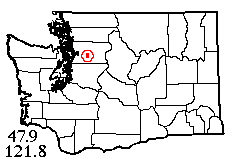 |
![]() 10 VI 2013: It was going to be the last nice day before another rainy spell, and no responses from alleged new volunteers, so I decided to bus back to Sultan one last time and hike farther up that abandoned logging road I visited in April, this time going beyond the 121.8 degree line into a medium-aged clearcut and adjacent forest. Seven dogs barked at me hiking up Sultan Basin Road (six on the way out); on the credit side, I passed a farmyard with several llamas grazing. The seral forest greeted me like an old friend with an offering of numerous ripe, luscious salmonberries! I quickly (well, with some pauses for berries) passed through the forest of small hemlocks, but when I arrived at the clearcut it was nowhere near as open as it looked in the aerial photos; more of a jungle of alders, shrubs, young conifers, and (alas) invasive blackberry vines. The clearcut site was not as silent as the nearby forest site had been, since an active logging road was only a quarter-mile ahead of me, but it was still pretty peaceful. The vegetation here produced only a middling diversity of spiders, lacking several common native species that I would have expected, evidently replaced by invasive spiders like Enoplognatha ovata that had colonized the cut-over land by ballooning. However, mid-sized grassy spaces (probably old log landings) had two active wolf spider species, and one big fat Evarcha jumping along. I backtracked a little ways to where I’d seen some maple trees to supplement the anemic foliage sample by sifting, and fortunately got 9 species from litter and moss for a total of 27 from the new area. Like I once said on TV, "another day, another spider."
10 VI 2013: It was going to be the last nice day before another rainy spell, and no responses from alleged new volunteers, so I decided to bus back to Sultan one last time and hike farther up that abandoned logging road I visited in April, this time going beyond the 121.8 degree line into a medium-aged clearcut and adjacent forest. Seven dogs barked at me hiking up Sultan Basin Road (six on the way out); on the credit side, I passed a farmyard with several llamas grazing. The seral forest greeted me like an old friend with an offering of numerous ripe, luscious salmonberries! I quickly (well, with some pauses for berries) passed through the forest of small hemlocks, but when I arrived at the clearcut it was nowhere near as open as it looked in the aerial photos; more of a jungle of alders, shrubs, young conifers, and (alas) invasive blackberry vines. The clearcut site was not as silent as the nearby forest site had been, since an active logging road was only a quarter-mile ahead of me, but it was still pretty peaceful. The vegetation here produced only a middling diversity of spiders, lacking several common native species that I would have expected, evidently replaced by invasive spiders like Enoplognatha ovata that had colonized the cut-over land by ballooning. However, mid-sized grassy spaces (probably old log landings) had two active wolf spider species, and one big fat Evarcha jumping along. I backtracked a little ways to where I’d seen some maple trees to supplement the anemic foliage sample by sifting, and fortunately got 9 species from litter and moss for a total of 27 from the new area. Like I once said on TV, "another day, another spider."
 |
![]() 22 VI 2013: Another trip into the mountain forests with Larry McTigue aiming to set pitfalls for grylloblattids did succeed in setting some, and got a good spider sample too. We went back up the Mountain Loop Highway, now open all the way around, past the Monte Cristo turnoff to head up the Sloan Creek road into the very heart of the Cascades. Our goal was a side road very near the end that passes about 4 clearcuts suitable for forest-edge pitfall trapping. Wouldn’t you know it, the side road was blocked! However, the first clearcut was in easy walking distance, and still looked pretty plain even though not very new. We scrambled up the lower edge, setting 10 traps in old-growth cedar. Who knows what they’ll get? Larry left his truck by the blocked road and headed off for a hike on a developed (but not identified by signs) trail a quarter mile farther on, while I collected.
22 VI 2013: Another trip into the mountain forests with Larry McTigue aiming to set pitfalls for grylloblattids did succeed in setting some, and got a good spider sample too. We went back up the Mountain Loop Highway, now open all the way around, past the Monte Cristo turnoff to head up the Sloan Creek road into the very heart of the Cascades. Our goal was a side road very near the end that passes about 4 clearcuts suitable for forest-edge pitfall trapping. Wouldn’t you know it, the side road was blocked! However, the first clearcut was in easy walking distance, and still looked pretty plain even though not very new. We scrambled up the lower edge, setting 10 traps in old-growth cedar. Who knows what they’ll get? Larry left his truck by the blocked road and headed off for a hike on a developed (but not identified by signs) trail a quarter mile farther on, while I collected.
My first concern was to gather active wolf spiders: both Pardosa dorsuncata and P. mackenziana were present, which is unusual (normally just one or the other). Three species were on an outhouse, including Novalena intermedia. Sweeping a small roadside field added six, and two more were under some of the stones in the pile that blocked the logging road – 13 species already! Among the spiders swept from grass was a female Misumena vatia preying on her mate, first time I’ve seen that in this species. It was a bit late in the year for sifting leaf litter, but I thought I’d try some. Among the alder trees were enough maples to make some pretty nice litter, and a couple hours work added six more species. We’d passed lots of mossy trees on the way in, but I found few at this particular site, adding only one species from moss. But the shaded grassy verge on the blocked logging road was fine, giving me 9 species including Dipoena lana and an inland range extension for Poeciloneta lyrica. I struggled up the steep hillside to sweep some understory off-trail, but it added only one more species. There was no accessible conifer foliage near the truck, but walking up and down brought me to 3 separate spots with a little to beat, among them adding 4 more species for 33 total, quite a nice catch. Larry returned from his hike (having encountered snow at a saddle), and the mosquitos, having been active all day, were getting even worse so I quit before dark; we were almost to Everett when the sun dazzlingly set.
Addendum: the pitfall traps, picked up July 28, added 10 spider species bringing the total to over 40. A ton of beetles too – but no grylloblattids!
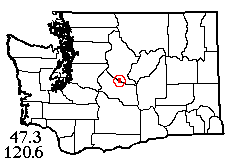 |
![]() 2 VII 2013: I have a new field volunteer, a real one! Her name is Maia Kreis and she was one of Scarab Sugden’s entomology students in Spring Quarter. We had our inaugural trip during the early-summer heat wave, so I chose a montane site, not too high because of the snow line: the ridge along the Kittitas/Chelan county line, upslope from Old Blewett Pass. We reached the old pass in short order, then headed up a dirt road that made us glad Maia had brought her dad’s SUV. Thanks to map printouts and some helpful hiker’s blue arrow signs, we successfully negotiated a confusing maze of increasingly bad roads and parked at a 4600’ elevation saddle shortly before the road becomes the County Line Trail. I needn’t have worried about snow here, there was none at all as far as the eye could see. A patchwork of logged land, mature true fir forest and sub-subalpine scree gave us plenty of habitats. First mission was to get a big sample from the traditionally best habitat in such terrain, conifer foliage; and we did that, 13 species of which 4 were Philodromus crab spiders including the rare P. rodecki. Finishing this in a patch of mature forest, I decided to try for spiders under bark and dead wood; in the end this only added 3-4 species. Back down along the road, I swept grass and herbs and Maia beat the numerous Ceanothus shrubs, each of which added only 2 species not on the trees. Pickings under rocks were especially slim, but I shouldn’t complain because I found a brand-new species of Nodocion there, with a colorful red carapace; oddly, It was under a Titanoeca web but I never did find the Titanoeca. Finally, we tried sifting conifer litter, but the snow had been gone so long that it was mostly dry, and I only found one patch damp enough to have good spiders, adding 2 species.
2 VII 2013: I have a new field volunteer, a real one! Her name is Maia Kreis and she was one of Scarab Sugden’s entomology students in Spring Quarter. We had our inaugural trip during the early-summer heat wave, so I chose a montane site, not too high because of the snow line: the ridge along the Kittitas/Chelan county line, upslope from Old Blewett Pass. We reached the old pass in short order, then headed up a dirt road that made us glad Maia had brought her dad’s SUV. Thanks to map printouts and some helpful hiker’s blue arrow signs, we successfully negotiated a confusing maze of increasingly bad roads and parked at a 4600’ elevation saddle shortly before the road becomes the County Line Trail. I needn’t have worried about snow here, there was none at all as far as the eye could see. A patchwork of logged land, mature true fir forest and sub-subalpine scree gave us plenty of habitats. First mission was to get a big sample from the traditionally best habitat in such terrain, conifer foliage; and we did that, 13 species of which 4 were Philodromus crab spiders including the rare P. rodecki. Finishing this in a patch of mature forest, I decided to try for spiders under bark and dead wood; in the end this only added 3-4 species. Back down along the road, I swept grass and herbs and Maia beat the numerous Ceanothus shrubs, each of which added only 2 species not on the trees. Pickings under rocks were especially slim, but I shouldn’t complain because I found a brand-new species of Nodocion there, with a colorful red carapace; oddly, It was under a Titanoeca web but I never did find the Titanoeca. Finally, we tried sifting conifer litter, but the snow had been gone so long that it was mostly dry, and I only found one patch damp enough to have good spiders, adding 2 species.
On our way back down, we stopped at a meadow along the Old Blewett Highway, very lush-looking but spiders decidedly patchy. Experience tells: Maia kept sweeping unproductive parts but I managed to zero in on better swatches and got 9 species, 5 of them different from what we’d taken a thousand feet higher. There were some gorgeous old Ponderosa trees here but the bark produced nothing (sorry Laurel, no cones seen), so we ended the day with 28 species. On the bright side, we'd seen almost no mosquitos and only a few biting flies alll day. I bribed Maia with a milkshake to stop at Mountain High Burgers on the way home. I think she was glad we had when blasting on the pass forced us to sit on I-90 for an hour before finally heading home to Seattle.
 |
![]() 13 VII 2013: On a Saturday with weather even more fair than predicted, Fred and Jerry Austin and I set out for a place I couldn’t resist: Spider Lake in the southeastern Olympic Mountains. The drive was longish (through Olympia and Shelton and about 25 miles of forest roads) but trouble-free to the lake, where we found one other car at the trailhead for a loop trail that goes all the way around, mostly through old-growth western hemlock, an unexpected bonus. I stopped after a quarter-mile in typical old-growth habitat while Fred and Jerry headed on around the loop. My first concern was to sift conifer litter, but I gave up after three spider-free loads; must have been too late for the litter fauna at 1300’ elevation. The dead wood fauna was better (3 species) and I got 3 more each from moss and understory before continuing around to the NW, upstream end of the lake. Here, a short side trail led out of the hemlock through concentric rings of alder, willow, Spiraea shrubland and sedge marsh to the lake shore. With all these habitats I had no trouble boosting the catch up to 24 species, with some help from Jerry who got 3 wolf-spider species to my one. Eris militaris, a common jumping spider, was doing very well here with exceptionally big specimens, and I sifted a rare Cybaeopsis from alder litter. Continuing on around the lake loop, I found Fred back at the car, having added one species from roadside verge; Jerry was now behind me, having gone around the lake twice!
13 VII 2013: On a Saturday with weather even more fair than predicted, Fred and Jerry Austin and I set out for a place I couldn’t resist: Spider Lake in the southeastern Olympic Mountains. The drive was longish (through Olympia and Shelton and about 25 miles of forest roads) but trouble-free to the lake, where we found one other car at the trailhead for a loop trail that goes all the way around, mostly through old-growth western hemlock, an unexpected bonus. I stopped after a quarter-mile in typical old-growth habitat while Fred and Jerry headed on around the loop. My first concern was to sift conifer litter, but I gave up after three spider-free loads; must have been too late for the litter fauna at 1300’ elevation. The dead wood fauna was better (3 species) and I got 3 more each from moss and understory before continuing around to the NW, upstream end of the lake. Here, a short side trail led out of the hemlock through concentric rings of alder, willow, Spiraea shrubland and sedge marsh to the lake shore. With all these habitats I had no trouble boosting the catch up to 24 species, with some help from Jerry who got 3 wolf-spider species to my one. Eris militaris, a common jumping spider, was doing very well here with exceptionally big specimens, and I sifted a rare Cybaeopsis from alder litter. Continuing on around the lake loop, I found Fred back at the car, having added one species from roadside verge; Jerry was now behind me, having gone around the lake twice!
All back together, we drove on up the forest road and up a side spur heading for Dusk Point, a nearby peak (former fire lookout) where we hoped to add higher-elevation species to the sample. A half mile before the top, the road narrowed a bit too much for Fred’s rather wide vehicle, so we got out and walked the remaining 500-feet elevation to the 3244-foot summit. Around and near the summit we mainly worked on conifer foliage, adding a number of species including Anyphaena pacifica and one of the undescribed Ceraticelus. Jerry couldn’t find anything under rocks, but his alder-beat sample added Cyclosa conica to the day’s catch. Back from Dusk Point to the car, appropriately enough at dusk, Fred said "it’s been a great trip" in a satisfied manner. Ten minutes later, he had a flat tire, slashed by a piece of bottle some glass-breaking jerk had littered the road with. Changing the tire with vanishing light and a somewhat cranky jack took about an hour, so we got home a bit later than planned, but with 34 species on the credit side.
Oh yes, the name of the lake! Well, the origin of the "Spider Lake" name doesn’t seem to be recorded anywhere. Obviously there are spiders there! But we rather suspect it was named for some non-spider, such as the harvestmen one might encounter in the fall, or the water striders common on the water surface there to this day…
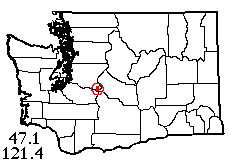 |
![]() 23 VII 2013: My volunteer Lauren Taylor had been very busy, but she gave me the welcome news that she’d be available for a field trip in late July. I’d been keeping track of snow melt in the mountains, and it was clearly time to go for treeline habitats. Kelly Butte, not far from the Cascade Crest along the Pierce-King County line, is a place I’ve been planning to visit for a few years. In the same gridspace are lower elevation habitats, so we were able to get good insurance for a full sample by making a brief stop where Road 7030 crosses the Greenwater River (2360’ elevation). Here, I quickly got a grass-herb sweep sample of 11 species, mostly duplicated (but with one more species) by Lauren’s conifer beating. From here, Lauren’s town car successfully negotiated the slightly-rough road to the Kelly Butte trailhead. At one point, driving along a narrow ridge crest triggered Lauren’s fear of heights, so I was afraid she’d be a basket case on the very steep trail, ascending 900 vertical feet in tight switchbacks with about 1000’ net horizontal advance. However, she found the trail so gorgeous, with mountains (including Rainier), flowers and rock formations, she decided if she fell she’d just die happy!
23 VII 2013: My volunteer Lauren Taylor had been very busy, but she gave me the welcome news that she’d be available for a field trip in late July. I’d been keeping track of snow melt in the mountains, and it was clearly time to go for treeline habitats. Kelly Butte, not far from the Cascade Crest along the Pierce-King County line, is a place I’ve been planning to visit for a few years. In the same gridspace are lower elevation habitats, so we were able to get good insurance for a full sample by making a brief stop where Road 7030 crosses the Greenwater River (2360’ elevation). Here, I quickly got a grass-herb sweep sample of 11 species, mostly duplicated (but with one more species) by Lauren’s conifer beating. From here, Lauren’s town car successfully negotiated the slightly-rough road to the Kelly Butte trailhead. At one point, driving along a narrow ridge crest triggered Lauren’s fear of heights, so I was afraid she’d be a basket case on the very steep trail, ascending 900 vertical feet in tight switchbacks with about 1000’ net horizontal advance. However, she found the trail so gorgeous, with mountains (including Rainier), flowers and rock formations, she decided if she fell she’d just die happy!
The summit area is mostly subalpine parkland, with scattered trees of subalpine fir, mountain hemlock, spruce, pine and cedar among shrubby and flowery meadows with a ton of beargrass. Bumble bees were incredibly abundant, especially on the flowering shrubs. Fortunately mosquitos were few and biting flies not common enough to be a major problem. A restored fire lookout is on the rocky summit (5409’); I stopped not far short of that in a clump of larger trees to sift litter, getting 5 species in as many loads of dead needles. I tried meadow-sweeping, getting a large handsome Pityohyphantes, but nothing further rewarded more effort, so I tried turning rocks near the summit. This gave me one Pardosa, a different Lepthyphantes and a really interesting-looking Dendryphantes jumping spider. Meanwhile, Lauren had been busily beating conifer foliage for hours and got hardly anything! I tried doing some myself and did a little better, but still only added one species to what we’d already taken. Was the mountain-top too dry? Were we too early or too late? In any case, it was a lucky thing we’d taken that lowland sample first! On the way down, one more species dropped from my sombrero, another from beating a trailside clump of thimbleberry. I’d managed to grab a Neriene radiata from a web among the cliff rocks on the way up. End result, 25-26 species for the area, on a day Lauren proclaims "my favorite hike I’ve ever been on!"
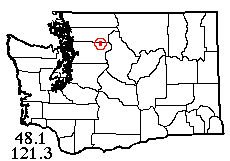 |
![]() 28 VII 2013: It was now time to return with Larry McTigue to Sloan Creek and retrieve those pitfall traps, with further plans for the rest of the day. We drove the long road up to our June 22 parking spot and I headed up to the clearcut-edge cedar grove where I’d placed (I thought) ten traps. The onus was on me to find them, since the red flagging tape was all but invisible to colorblind Larry. I found nine, but the last one (number three?) finally eluded both of us, if it ever existed. See above for results! Next, up the White Chuck River to set new traps at higher elevation sites on forest road 2311. Alas, the road was blocked – the fate of too many forest roads recently, it seems. We had a backup plan for the road over Rat Trap Pass, north from the highest point a car can reach on the White Chuck. But in the first couple of steep switchbacks, Larry’s truck engine started gasping for air due to some unknown problem, so he decided we’d better not ascend any further than the trailhead for Meadow Mountain and Crystal Lake, where he’d planned to hike while I collected. Another nearby side road had also disappeared.
28 VII 2013: It was now time to return with Larry McTigue to Sloan Creek and retrieve those pitfall traps, with further plans for the rest of the day. We drove the long road up to our June 22 parking spot and I headed up to the clearcut-edge cedar grove where I’d placed (I thought) ten traps. The onus was on me to find them, since the red flagging tape was all but invisible to colorblind Larry. I found nine, but the last one (number three?) finally eluded both of us, if it ever existed. See above for results! Next, up the White Chuck River to set new traps at higher elevation sites on forest road 2311. Alas, the road was blocked – the fate of too many forest roads recently, it seems. We had a backup plan for the road over Rat Trap Pass, north from the highest point a car can reach on the White Chuck. But in the first couple of steep switchbacks, Larry’s truck engine started gasping for air due to some unknown problem, so he decided we’d better not ascend any further than the trailhead for Meadow Mountain and Crystal Lake, where he’d planned to hike while I collected. Another nearby side road had also disappeared.
This was a lower elevation than I’d planned on for so late in the summer (under 2600’ at the trailhead), but feeling I might as well give it a good try, I started by walking along 400 meters of road, sweeping the roadside verge. Spiders were sparse but in the end I had 9 species (including a Clubiona that matured 2 days later, and a new state record for Dipoena malkini!). Then I hiked a ways up the trail, looking for better habitats. I stopped at what appeared on aerial photos to be a meadow. From nearby, it was clear it was shrubs of some kind – but I was almost upon it before I discovered it was all vine maple, not much there to sweep! However, it was a lucky spot anyway because a very nice grove of old growth western hemlock was hiding along the edge. Sifting litter here got me 5 species, with 2 more from moss. Back on the trail (really an old road), I concentrated on beating foliage of the many young hemlock trees. Again, it was very slow going at first, but I eventually hit a more productive section and added 5 species. A shaded rocky talus area looked very promising but had practically no spiders, still adding one Pardosa species. Working my way back, I found one aerial Zygiella dispar web and swept a couple more species along the trail, passed by Larry who had been all the way to Crystal Lake and was now zooming back to the car! End result, 24 species; at least it’s a sample.
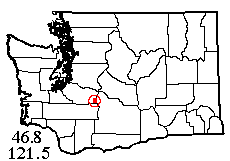 |
![]() 7 VIII 2013: Friend and volunteer Della Scott had the loan of a car from a pet-sitting client, with permission to use it on a field trip. With us were Ripple the dog (Della’s charge) and Jerry Austin. I’ve been hoping for years to collect at Chinook Pass, where various people have taken only 5 species in the past. We parked at the Pacific Crest trailhead there (just outside Mt. Rainier National Park, classic subalpine parkland at 5440’ elevation) and I headed a short distance up the trail until I spied a big enough tree group to contain conifer litter, one of the best habitats at this season. True to form, although I sifted only 10 specimens they represented 6 species. Then I wandered about in that and other nearby tree groups tapping spiders from dead wood fragments, another great habitat. I had to pick and choose carefully because if the tree group was too sunny, the wood was too dry for spiders, but eventually I had 40 specimens of 9 species. I tried sweeping the lovely meadows but as expected, it was too late in the season and I only added 2 species. The rest of my time until dusk, I beat conifer foliage, finally ending the day with 19 species.
7 VIII 2013: Friend and volunteer Della Scott had the loan of a car from a pet-sitting client, with permission to use it on a field trip. With us were Ripple the dog (Della’s charge) and Jerry Austin. I’ve been hoping for years to collect at Chinook Pass, where various people have taken only 5 species in the past. We parked at the Pacific Crest trailhead there (just outside Mt. Rainier National Park, classic subalpine parkland at 5440’ elevation) and I headed a short distance up the trail until I spied a big enough tree group to contain conifer litter, one of the best habitats at this season. True to form, although I sifted only 10 specimens they represented 6 species. Then I wandered about in that and other nearby tree groups tapping spiders from dead wood fragments, another great habitat. I had to pick and choose carefully because if the tree group was too sunny, the wood was too dry for spiders, but eventually I had 40 specimens of 9 species. I tried sweeping the lovely meadows but as expected, it was too late in the season and I only added 2 species. The rest of my time until dusk, I beat conifer foliage, finally ending the day with 19 species.
Meanwhile, Jerry had ascended to the rocky ridge crest running NE from Yakima Peak, where his conifer foliage sample included 2 species not in mine, he found active Pardosa mackenziana and Micaria constricta, and best of all, the very rare gnaphosid Parasyrisca orites under rocks; only the second time in Washington that it’s been found off the type locality of Mt. Rainier. With the prior samples, we boosted the grid-area to 27 species. The dog had a good time too!
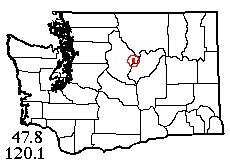 |
![]() 5-11 X 2013, The Great Spokane County Expedition: My old friend and former volunteer Laurel Ramseyer (she of the pine-cone obsession) has been living in Massachusetts, writing up the results of her studies of pine-cone spiders. This fall she decided she wanted comparative data on the spider fauna of Ponderosa pine cones and the needle litter on which they lay. To do this she needed to return to Washington, and naturally I accepted her offer of a fall eastern-Washington expedition.
5-11 X 2013, The Great Spokane County Expedition: My old friend and former volunteer Laurel Ramseyer (she of the pine-cone obsession) has been living in Massachusetts, writing up the results of her studies of pine-cone spiders. This fall she decided she wanted comparative data on the spider fauna of Ponderosa pine cones and the needle litter on which they lay. To do this she needed to return to Washington, and naturally I accepted her offer of a fall eastern-Washington expedition.
5 X: On Saturday morning we set off across Stevens Pass. After a slowdown near the fake "Oktoberfest" at Leavenworth, we made good time to Lake Chelan; and the rental car, which looked incapable of such heroics, actually made it up steep, rocky Bear Mountain Road, nosing through a reluctant-to-move group of deer. We decided on the north ridge of Bear Mountain, home of a microwave tower, as our main site, near a partial sample of 8 species from 2011. Laurel sampled several species from the cones and litter in 2 pine groves, while I beat pine foliage, shrubs including some very aromatic sagebrush, and swept grass and herbs. Laurel located the web of a nice healthy black widow, before heading to Mom's Motel in Chelan. Left alone, I beat 10 species from Douglas-firs and sifted two more from shrub litter; by this point we already had 21 species (including 4 linyphiids I didn't recognize), not counting the former records. As the sun set I got my campsite all ready and then took a walk in the dark around the mountaintop roads, trying to kill time before going to bed with dawn nearly 12 hours away. The stars were dim due to moist air, but the lights of Chelan spread out below a viewpoint almost like the big city it isn't.
6 X: In the morning I was up in time to add sunrise photos for the album, then packed and looked under rocks until Laurel arrived. We headed on down the far side of Bear Mountain and stopped on Bear Creek at the entrance of a mysterious private wildlife refuge. Here there was a large tract of grassland, too dewy for sweeping, some pine groves and some nice riparian cottonwood whose litter yielded 9 spider species (including another unfamiliar one). Laurel's cone sample here produced only 2 spiders, the pine litter none. In all, 30 species making 36 with the prior records: the 500th Washington gridspace with a spider sample! Descending to Navarre Coulee Road, we sought 2 national forest access roads on the far side; one was blocked, the other seemingly nonexistent.
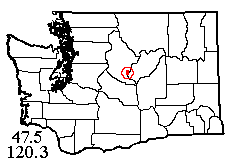 |
![]() 6 X 2013, continued: So on down to our main goal for the day, Swakane Canyon, much of it burned in July 2010 but with much pine and other habitat still surviving. We drove up to an area frequented by butterfliers, and after laying the parts of my tent out to dry in the sun, I swept 8 spider species from a huge tall-grass meadow while Laurel prospected for pine cones. Near where I'd been sweeping, a rattlesnake warned Laurel off a promising rocky site. At our parking spot there was no good tent site, so I followed Laurel up the road and found an area with several good flat spots (but with rocky ground as I found out later!). Here I beat pine foliage, adding only one identifiable species, and swept the understory of riparian aspen/dogwood forest (apparently not burned in the fire), getting a diverse array of mostly juvenile stuff and adding 3 spider species. Laurel's cone-beating here was much more successful, two of the samples adding 7 identifiable spider species, and just generally an interesting fauna. (Pine litter was practically non-existent; probably went up in smoke).
6 X 2013, continued: So on down to our main goal for the day, Swakane Canyon, much of it burned in July 2010 but with much pine and other habitat still surviving. We drove up to an area frequented by butterfliers, and after laying the parts of my tent out to dry in the sun, I swept 8 spider species from a huge tall-grass meadow while Laurel prospected for pine cones. Near where I'd been sweeping, a rattlesnake warned Laurel off a promising rocky site. At our parking spot there was no good tent site, so I followed Laurel up the road and found an area with several good flat spots (but with rocky ground as I found out later!). Here I beat pine foliage, adding only one identifiable species, and swept the understory of riparian aspen/dogwood forest (apparently not burned in the fire), getting a diverse array of mostly juvenile stuff and adding 3 spider species. Laurel's cone-beating here was much more successful, two of the samples adding 7 identifiable spider species, and just generally an interesting fauna. (Pine litter was practically non-existent; probably went up in smoke).
After Laurel headed for her Wenatchee hotel, I sifted deciduous litter until dark, adding 9 species not otherwise taken, thus rescuing the day's catch from mediocrity. After dark (all the target shooters having departed), I hiked a mile or a mile and a half up the canyon road faintly visible by starlight, watching Venus set behind the ridge, seeing a meteor, and hearing various decticids still singing, plus a faint windy roaring (origin unknown) over the ridge; got to bed at 9:30, less than 10 hours until daylight. The day's catch included several excellent records plus a possible new species of Micaria (or a very atypical M. pulicaria).
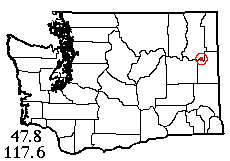 |
![]() 7 X 2013: Laurel showed up on schedule in the morning and we headed clear across the state, to spend the rest of our trip in the extensive pine forest areas of Spokane County. That county has a very successful program of acquiring property for habitat conservation in "conservation areas," and the remaining days of our trip were largely devoted to visiting these excellent sites plus a couple of county parks. The sites have very nice spider habitats, as well as enjoyable trail systems and abundant other wildlife. Today's goal was the McLellan Conservation Area, 410 acres at the tip of a north-jutting peninsula surrounded by Spokane River waters impounded by Nine Mile Dam. From the parking lot we hiked down the trail to a riparian zone along the river bank, and I had just taken 5 species in a shoreline sweep sample when the clouds burst! (Anyway, I couldn't have swept much farther without hitting poison ivy...) We sheltered under trees during two brief but drenching thunder-showers (not too wisely, but no lightning struck nearby), leaving me nothing much further to do but sift litter. However, a strong wind (which eventually made the litter sifting too difficult) actually dried out the trees, allowing me to get an excellent conifer foliage sample (9 species added) as well. The alder-pine litter along the shore was really great, giving me 14 identifiable spider species including at least 2 I didn't recognize. Meanwhile, Laurel had obtained unusually rich samples from riparian pine cones and pine litter, adding 4 more spider species.
7 X 2013: Laurel showed up on schedule in the morning and we headed clear across the state, to spend the rest of our trip in the extensive pine forest areas of Spokane County. That county has a very successful program of acquiring property for habitat conservation in "conservation areas," and the remaining days of our trip were largely devoted to visiting these excellent sites plus a couple of county parks. The sites have very nice spider habitats, as well as enjoyable trail systems and abundant other wildlife. Today's goal was the McLellan Conservation Area, 410 acres at the tip of a north-jutting peninsula surrounded by Spokane River waters impounded by Nine Mile Dam. From the parking lot we hiked down the trail to a riparian zone along the river bank, and I had just taken 5 species in a shoreline sweep sample when the clouds burst! (Anyway, I couldn't have swept much farther without hitting poison ivy...) We sheltered under trees during two brief but drenching thunder-showers (not too wisely, but no lightning struck nearby), leaving me nothing much further to do but sift litter. However, a strong wind (which eventually made the litter sifting too difficult) actually dried out the trees, allowing me to get an excellent conifer foliage sample (9 species added) as well. The alder-pine litter along the shore was really great, giving me 14 identifiable spider species including at least 2 I didn't recognize. Meanwhile, Laurel had obtained unusually rich samples from riparian pine cones and pine litter, adding 4 more spider species.
While I finished off by the river, Laurel headed back up the trail to collect from upland pine cones (getting a decent sample). Her habitat was pure pine forest and nothing else, offering few habitats for me, so I helped her sift pine litter – which contained not a creature! Still, our brief (and moist) stay here netted us 36 spider species in all! I'd intended to camp near here, but with the prospect of more downpours on the way I must confess I wimped out for the night.
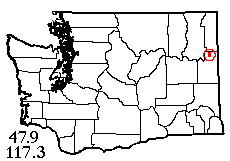 |
![]() 8 X 2013: Tuesday was predicted to be even rainier than Monday, considering which, we did all right. After breakfast at a McDonalds where a sort of "club" of nice people quizzed me about spiders, we began at the farthest north of our planned sites, Bear Lake County Park (east of the town of Deer Park). Contrary to reports, we were able to drive into the park and found what saved the day for me – a roofed picnic shelter with tables to sift on! I tried one load of cottonwood litter from a nearby lakeshore grove, found the sifting only fair, and decided to try for conifer foliage samples before it really began to rain. I was glad I did, getting 6 species from pine and Douglas-fir foliage. The leaf litter was really thin, mainly this year's leaves, but got somewhat better as I kept getting more bags of litter from a little farther out in the partly-dry marsh. A lot of the litter catch consisted of Pirata wolf spiders and Clubiona (2 species of each), with few, but very good, linyphiids. A highlight was 2 juvenile Dolomedes fishing spiders. I had one good bag-full with me in the shelter when the clouds really burst, enabling me to finish sifting in comfort instead of getting drenched, and I ended our visit to Bear Lake with 19 species primarily from 2 main habitats. Laurel's pine-cone and litter catches, including a possibly new Drassyllus species (near D. orgilus of Texas), brought us up to 27 species for Bear Lake.
8 X 2013: Tuesday was predicted to be even rainier than Monday, considering which, we did all right. After breakfast at a McDonalds where a sort of "club" of nice people quizzed me about spiders, we began at the farthest north of our planned sites, Bear Lake County Park (east of the town of Deer Park). Contrary to reports, we were able to drive into the park and found what saved the day for me – a roofed picnic shelter with tables to sift on! I tried one load of cottonwood litter from a nearby lakeshore grove, found the sifting only fair, and decided to try for conifer foliage samples before it really began to rain. I was glad I did, getting 6 species from pine and Douglas-fir foliage. The leaf litter was really thin, mainly this year's leaves, but got somewhat better as I kept getting more bags of litter from a little farther out in the partly-dry marsh. A lot of the litter catch consisted of Pirata wolf spiders and Clubiona (2 species of each), with few, but very good, linyphiids. A highlight was 2 juvenile Dolomedes fishing spiders. I had one good bag-full with me in the shelter when the clouds really burst, enabling me to finish sifting in comfort instead of getting drenched, and I ended our visit to Bear Lake with 19 species primarily from 2 main habitats. Laurel's pine-cone and litter catches, including a possibly new Drassyllus species (near D. orgilus of Texas), brought us up to 27 species for Bear Lake.
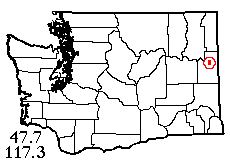 |
![]() 8 X 2013, continued: Our directions to Haynes Estate Conservation Area (a largely-natural 97 acres in the midst of Spokane's suburbs) unfortunately pre-dated a traffic revision. We just could not find that "Shady Slope Road." After wasting about half an hour we discovered that you can only access this road when northbound on the highway, not southbound from Bear Lake. When we arrived at the site parking lot, it was miraculously still dry. As we stepped out of the car, it started to rain! Laurel went off to get a sample from rained-on pine cones, while I worked like a fiend to sweep some grass and beat some fir foliage before it got too wet. It was such a nice spot that I had 9 spider species by the time I had to retreat under the little "roof" of the park signage to keep me (sans raincoat) and my net dry. The sign itself produced a female of wood-dwelling jumping spider Platycryptus californicus. Laurel eventually returned with her cone sample during a letup of the rain, and reported the ruins of an old shed that might have spiders under the boards. There weren't many, but I eventually rounded up a male of Laurel's new Drassyllus and a female Tegenaria agrestis (hobo spider). We'd now taken the 2 most notorious spider species in the area … and had 11 species already from the Haynes Estate. Rain clouds now hovered over much of the area, but the weather prophets said tomorrow would be better!
8 X 2013, continued: Our directions to Haynes Estate Conservation Area (a largely-natural 97 acres in the midst of Spokane's suburbs) unfortunately pre-dated a traffic revision. We just could not find that "Shady Slope Road." After wasting about half an hour we discovered that you can only access this road when northbound on the highway, not southbound from Bear Lake. When we arrived at the site parking lot, it was miraculously still dry. As we stepped out of the car, it started to rain! Laurel went off to get a sample from rained-on pine cones, while I worked like a fiend to sweep some grass and beat some fir foliage before it got too wet. It was such a nice spot that I had 9 spider species by the time I had to retreat under the little "roof" of the park signage to keep me (sans raincoat) and my net dry. The sign itself produced a female of wood-dwelling jumping spider Platycryptus californicus. Laurel eventually returned with her cone sample during a letup of the rain, and reported the ruins of an old shed that might have spiders under the boards. There weren't many, but I eventually rounded up a male of Laurel's new Drassyllus and a female Tegenaria agrestis (hobo spider). We'd now taken the 2 most notorious spider species in the area … and had 11 species already from the Haynes Estate. Rain clouds now hovered over much of the area, but the weather prophets said tomorrow would be better!
 |
![]() 9 X 2013: In the morning we headed northeast to the Little Spokane (state) Natural Area, accessed by the Painted Rocks Trail (named for a pictograph near the trailhead). We warmed up by hiking the entire length of the trail (1.75 miles to another trailhead) while the fog lifted and the wet foliage began to dry. On the way back, we hit a spot where the pine cones looked good to Laurel and a big meadow (with cottonwoods along the river) looked good to me. A little sweeping found the meadow still borderline wet in parts, so I spent some time sifting cottonwood litter, which was rather thin and poor here. This was the only site of the trip where I didn't get a nice array of linyphiid spiders from sifting: the litter sample had only 5 species. Pine foliage added 3, including the day's prize, odd-looking crab spider Tmarus angulatus. Sweeping the eventually dry meadow added 7 species. Laurel's cone samples produced little here as well, and it was obvious we needed more species for a full sample. Hiking back, we watched carefully for Douglas-fir trees, my main hope for more records. At first, they were sparse and with few low branches, but we did ultimately find some good ones that added 8 more species (including the first eastern-Washington record of invasive Philodromus dispar). Laurel, checking under pine bark scales, found lots of Bassaniana utahensis, and I added a Frontinella from Oregon-grape. In the end we had only a fair sample of 23 species from here, not as good for the time spent as any of the county property sites.
9 X 2013: In the morning we headed northeast to the Little Spokane (state) Natural Area, accessed by the Painted Rocks Trail (named for a pictograph near the trailhead). We warmed up by hiking the entire length of the trail (1.75 miles to another trailhead) while the fog lifted and the wet foliage began to dry. On the way back, we hit a spot where the pine cones looked good to Laurel and a big meadow (with cottonwoods along the river) looked good to me. A little sweeping found the meadow still borderline wet in parts, so I spent some time sifting cottonwood litter, which was rather thin and poor here. This was the only site of the trip where I didn't get a nice array of linyphiid spiders from sifting: the litter sample had only 5 species. Pine foliage added 3, including the day's prize, odd-looking crab spider Tmarus angulatus. Sweeping the eventually dry meadow added 7 species. Laurel's cone samples produced little here as well, and it was obvious we needed more species for a full sample. Hiking back, we watched carefully for Douglas-fir trees, my main hope for more records. At first, they were sparse and with few low branches, but we did ultimately find some good ones that added 8 more species (including the first eastern-Washington record of invasive Philodromus dispar). Laurel, checking under pine bark scales, found lots of Bassaniana utahensis, and I added a Frontinella from Oregon-grape. In the end we had only a fair sample of 23 species from here, not as good for the time spent as any of the county property sites.
![]() Finishing at the natural area trail, we had too few hours of daylight left to get a whole sample anywhere else. Fortunately we were already halfway there at the Haynes Estate site, so we returned there (now sunny and dry) and took the trail down to riparian habitats, likewise along the Little Spokane River. Here I added 2 species sweeping river-bank grass, and tried sifting the cottonwood litter. Not a thing in the first load, exclusively this year's leaves (presumably the older leaves had been washed away when the river was in flood). I worked my way up the steep banks in search of non-drowned litter, and finally got some decent spiders in litter that was more than half pine: 10 species. Laurel's pine cone and litter samples here added 2 more, so we had 24 species from this area after very short parts of 2 days spent here.
Finishing at the natural area trail, we had too few hours of daylight left to get a whole sample anywhere else. Fortunately we were already halfway there at the Haynes Estate site, so we returned there (now sunny and dry) and took the trail down to riparian habitats, likewise along the Little Spokane River. Here I added 2 species sweeping river-bank grass, and tried sifting the cottonwood litter. Not a thing in the first load, exclusively this year's leaves (presumably the older leaves had been washed away when the river was in flood). I worked my way up the steep banks in search of non-drowned litter, and finally got some decent spiders in litter that was more than half pine: 10 species. Laurel's pine cone and litter samples here added 2 more, so we had 24 species from this area after very short parts of 2 days spent here.
Now it was time to head for my night's camp site near Newman Lake. It was the only actual campground (other than exorbitant state parks and such) I could find in the whole county. To get there we tried a "short cut" which ran us afoul of terrible traffic on Highway 2 and a confusing network of back roads that seemed to change names every time we looked. We didn't exactly get lost, but it was dark by the time we reached the vicinity of Homestead Campground. I'd found little info on this place, shown on the topo map, but it was DNR land and I assumed it would be possible to camp there. Alas, the very roads that go there don't even seem to exist any more. We finally stopped at a gated, overgrown road that I assumed was the old campground access (turns out it wasn't), and found a place behind the old gate to erect my tent under the glare of Laurel's headlights. This tent erection should have been recorded on video and set to Laurel and Hardy's theme music, but our Laurel was too tired to be very amused. However, I finally got set up and actually spent quite a comfortable night in this obscure spot.
 |
![]() 10 X 2013: Leaving my tent set up (but removing sleeping bag and other valuables), we set out this morning for the 421-acre McKenzie Conservation Area on the NW shore of Newman Lake. There were plenty of pines by the paved road, but darned few met our gaze as we hiked down an attractive trail toward the lake. After the trail turned, paralleling the lake, we eventually came to a stretch with forest on our left and extensive riparian marshy meadows to our right. Here, there were some pine areas with cones and Laurel started work with one pine grove on a rocky knoll. At this site, the pine cones and tree foliage only gave us 5 spider species, so I headed for different sites. Two habitats were about equally productive. One, an area with white-trunked cottonwoods (looking very birchy) growing in a grassy plain, merging into denser cottonwood with nice deep litter, and grand fir on the slopes above, gave me 4 species (including Ozyptila beaufortensis) from grass-cottonwood litter, a number of others from pure cottonwood litter, and 8 from fir foliage. I headed back and met Laurel halfway near a service building with a nice native plant garden at the edge of the marsh. Here I got 2 species from the building, only 4 from meadow-sweeping, but Laurel added about 7 from the cones and litter of 2 different pine areas. We ended our work at this site with 28 species.
10 X 2013: Leaving my tent set up (but removing sleeping bag and other valuables), we set out this morning for the 421-acre McKenzie Conservation Area on the NW shore of Newman Lake. There were plenty of pines by the paved road, but darned few met our gaze as we hiked down an attractive trail toward the lake. After the trail turned, paralleling the lake, we eventually came to a stretch with forest on our left and extensive riparian marshy meadows to our right. Here, there were some pine areas with cones and Laurel started work with one pine grove on a rocky knoll. At this site, the pine cones and tree foliage only gave us 5 spider species, so I headed for different sites. Two habitats were about equally productive. One, an area with white-trunked cottonwoods (looking very birchy) growing in a grassy plain, merging into denser cottonwood with nice deep litter, and grand fir on the slopes above, gave me 4 species (including Ozyptila beaufortensis) from grass-cottonwood litter, a number of others from pure cottonwood litter, and 8 from fir foliage. I headed back and met Laurel halfway near a service building with a nice native plant garden at the edge of the marsh. Here I got 2 species from the building, only 4 from meadow-sweeping, but Laurel added about 7 from the cones and litter of 2 different pine areas. We ended our work at this site with 28 species.
Today, more nice weather had been predicted but it remained cloudy and semi-threatening, with only the "odd chink of blue" as British weathermen would say. Still, it hadn't rained. As Laurel drove me back to my campsite, we could see one active raincloud across the lake, probably raining on where we had just collected. Then it started raining on us! In all, it probably rained on my tent for about 20 minutes, not enough to make it unusable but enough to quash any thought of collecting there. I zipped myself in and read P.G. Wodehouse until dark, then spent a long night under the dripping trees. No more rain, but…
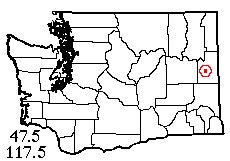 |
![]() 11 X 2013: The morning of our last day actually dawned! (In other words, yesterday's clouds were largely gone). My campsite was still very wet, so as I packed I found various clever places to perch my worldly goods that were still dry. The bag of tent stakes went on top of one of the gate posts. After Laurel arrived, I was making trips from the camp to the car when I heard a crash. The bag of stakes had fallen down inside the hollow post, to the very bottom (open end down)! Using a hooked stick, we did manage to fish the bag out. It still contained one stake. If I'd had a magnet, I might have been able to get the others out – if the hollow gate post hadn't been made of rusty iron…
11 X 2013: The morning of our last day actually dawned! (In other words, yesterday's clouds were largely gone). My campsite was still very wet, so as I packed I found various clever places to perch my worldly goods that were still dry. The bag of tent stakes went on top of one of the gate posts. After Laurel arrived, I was making trips from the camp to the car when I heard a crash. The bag of stakes had fallen down inside the hollow post, to the very bottom (open end down)! Using a hooked stick, we did manage to fish the bag out. It still contained one stake. If I'd had a magnet, I might have been able to get the others out – if the hollow gate post hadn't been made of rusty iron…
Anyway, I was done camping for the duration (even if I hadn't lost my stakes). We had breakfast, very delicious, at Barlow's restaurant in Liberty Lake, then headed west and south toward Cheney and our last collecting site: Fish Lake County Park. On arrival, the sun was out and the sky blue. I found a source of litter near the boat launch area and a picnic table to sift on, so I was happy, and Laurel hiked partway around the lake, finding a site with both pine cones and litter somewhat productive. I sifted 8 spider species from the cottonwood litter and 2 more (non-native) from willow litter in the crotch of a giant willow on the park lawn. A spruce tree added one species, and then it was time to sweep lake-shore grass. Aeshna dragonflies were mating in the cattails. Before long I was saying "Holy Ike!" at a half-grown fishing spider in the sweep net! In all, I swept 6 species. Meanwhile, Laurel had stopped at a dock and sluice gate and gathered 6 more species, mostly from webs on the structures. We left here shortly after mid-day with 22 species to add to the 11 I'd taken nearby way, way back in 1972.
Now it only remained to do the marathon drive back to Seattle. Fueled by ice cream cones in Moses Lake, we made it all the way to Easton, where we just had to stop at our favorite burger joint, Mountain High Hamburgers. Gloomy clouds closed in on the pass. Back at my apartment, Macavity was glad to see me, and I him!
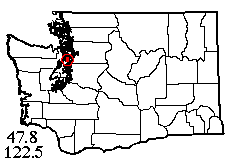 |
![]() 30 X 2013: A spell of nice weather was due to end tonight, and I wanted to get another sample while the fall colors were still out and before the early nights of standard time. No rides being in prospect, I took 3 buses and a ferry (passing a pod of orca whales) to the north Kitsap County town of Kingston, with access to 4 different grid-areas (2 sampled in previous years). My goal this time was a nature trail to Carpenter Lake, said to start from the rear of a local elementary school. I'd walked almost to the school turnoff (as it turns out, it was 200 feet in front of me) when I saw some hikers emerge from the side of the road. Reaching that point, I saw a trail with sign "Public Trail." Aha, I thought, they've extended the Carpenter Lake trail out to the main road. So I innocently strolled up this trail (through some nice habitats) and ended up, not at Carpenter Lake, but at the edge of school grounds. Oh well, I thought, the main trail must take off from the back of the school like the website said. What the website hadn't mentioned was all the "No public access during school hours" signs that kept bouncing me from place to place. There were well-beaten trails all over the place, none of them labeled Carpenter Lake. Little did I suspect that my short cut had taken me to the wrong school, a new high school whose access road comes from a whole other direction. I did find a collecting spot near a little wetland, and took a GPS reading to find out where in blazes I was. Oops, too far south and in the wrong gridspace! Back to the drawing board, and still ignorant of my original mistake, I wandered around some more (nobody challenged me for being there) and ended up in a patch of woods below a peripheral parking lot. This time the GPS put me just barely in the right area, so I made the best of it and settled down to collect until school hours should be over.
30 X 2013: A spell of nice weather was due to end tonight, and I wanted to get another sample while the fall colors were still out and before the early nights of standard time. No rides being in prospect, I took 3 buses and a ferry (passing a pod of orca whales) to the north Kitsap County town of Kingston, with access to 4 different grid-areas (2 sampled in previous years). My goal this time was a nature trail to Carpenter Lake, said to start from the rear of a local elementary school. I'd walked almost to the school turnoff (as it turns out, it was 200 feet in front of me) when I saw some hikers emerge from the side of the road. Reaching that point, I saw a trail with sign "Public Trail." Aha, I thought, they've extended the Carpenter Lake trail out to the main road. So I innocently strolled up this trail (through some nice habitats) and ended up, not at Carpenter Lake, but at the edge of school grounds. Oh well, I thought, the main trail must take off from the back of the school like the website said. What the website hadn't mentioned was all the "No public access during school hours" signs that kept bouncing me from place to place. There were well-beaten trails all over the place, none of them labeled Carpenter Lake. Little did I suspect that my short cut had taken me to the wrong school, a new high school whose access road comes from a whole other direction. I did find a collecting spot near a little wetland, and took a GPS reading to find out where in blazes I was. Oops, too far south and in the wrong gridspace! Back to the drawing board, and still ignorant of my original mistake, I wandered around some more (nobody challenged me for being there) and ended up in a patch of woods below a peripheral parking lot. This time the GPS put me just barely in the right area, so I made the best of it and settled down to collect until school hours should be over.
My bad luck was gone. The maple (with some alder) litter I sifted was amazingly productive. I sifted about 5 plastic bags full, and already had 20 spider species plus assorted other arthropods. There was even an adult newt in the litter (the habitat must be wetter at times than it was today). A couple bags of moss added 7 more species; cedar foliage and fern foliage brought me up to 32 species. Now it was late enough in the day that I could wander freely, so I climbed back up to the school grounds and beat some Douglas-fir foliage for 2 more species. Now I was determined to find the right trail! Each one I tried went nowhere in particular, until finally I found one that went just a short distance northeast to open on the grounds of a whole other school. Light dawned – dis must be de place! I went around to the elementrary school parking lot (no limited public access here, oddly enough) and the way to the trailhead was clearly enough marked. The official trail to Carpenter Lake is actually very short, and about half of it is a securely fenced boardwalk, so I wasn't able to do much collecting in the best habitats (including an apparent Sphagnum bog). I did get a Theridion simile from the Spiraea bushes and swept several species from a grass field. A gigantic bird (likely a heron) was splashing across the lake. End result, 39 spider species for the day despite being lost!
2013 is history, but 2014 collecting has begun! Stay tuned for the next exciting adventures!
This page last updated 21 March, 2025